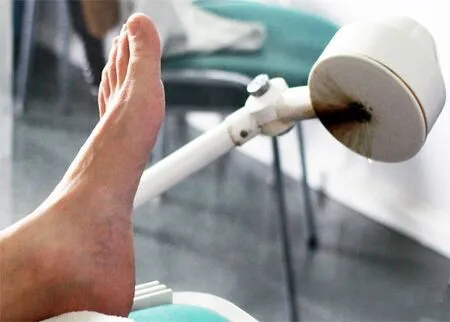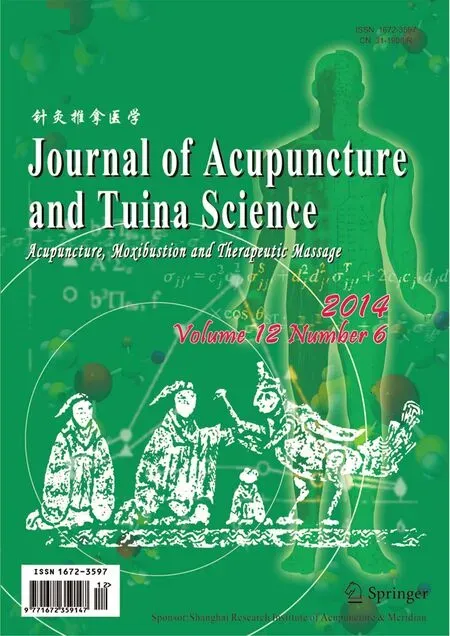Clinical Observation of Chinese Herbal Fumigation plus Mulberry Stick Beating for Heel Pain
2014-06-27
Jiaxing Hospital of Chinese Medicine, Zhejiang 314000, China
SPECIAL TOPIC STUDY
Clinical Observation of Chinese Herbal Fumigation plus Mulberry Stick Beating for Heel Pain
Shen Qing-he, Shen Zhi-fang, Yan Yu-qin, Zhu Gao-feng
Jiaxing Hospital of Chinese Medicine, Zhejiang 314000, China
Author:Shen Qing-he, bachelor, Chinese medicine physician.
E-mail: shenqh2014@163.com
Objective: To observe the clinical efficacy of Chinese herbal fumigation plus beating with mulberry stick in treating heel pain.
Methods: Sixty patients with heel pain were randomized into a treatment group and a control group, 30 in each group. The treatment group was intervened by Chinese herbal fumigation plus beating with mulberry stick, and the control group was by orally taking Diclofenac Sodium Sustained Release Tablets plus external use ofShe Xiang Zhen Tong Gao(Moschus Analgesic Plaster). After one treatment course, the visual analogue scale (VAS) was used to observe the change of pain, and the clinical efficacies were also evaluated.
Results: After intervention, the improvement of VAS score in the treatment group was more significant than that in the control group (P<0.01). The total effective rate of the treatment group was significantly higher than that of the control group (P<0.01).
Conclusion: Chinese herbal fumigation plus beating with mulberry stick can produce a higher clinical efficacy than orally taking Diclofenac Sodium Sustained Release Tablets in treating heel pain.
Drugs, Chinese Herbal; Fumigation; Flapping Therapy; Tuina; Massage; Points, Ashi; Heel Pain
Heel pain is a common complaint among the middle-aged and elderly population, manifested as distending sore or stabbing pain on one or both sides of heels or the bottom of feet, causing difficulty walking, and seriously affecting the life and work of the patients[1-3]. From the year 2009 to 2012, we adopted Chinese herbal fumigation plus beating with mulberry stick in treating heel pain. The report is given as follows.
1 Clinical Materials
1.1 Diagnostic criteria[1]
Pain on one or both sides of heel or planta pain, worsened by standing or walking and eased by rest; tender point found in or right before the weight bearing area of heel; X-ray exam revealing presence or absence of calcaneal spur.
1.2 Inclusion criteria
In conformity with the above diagnostic criteria; with no sex predilection; age 45-80 years old; willing to participate the study and having signed the informed consent form.
1.3 Exclusion criteria
Heel pain caused by calcaneal fracture, osteomyelitis, tuberculosis, or tumor; infectious reactions in the topical area.
1.4 Statistical method
The SPSS 13.0 version software was used for data analyses. The measurement data were expressed by mean ± standard deviationthe inter-group comparison was performed byt-test, while the intra-group comparison was by pairedt-test. Comparison of rate was conducted by Chi-square test. AP-value <0.05 indicated a statistical significance.
1.5 General data
Sixty patients with heel pain were enrolled from the Tuina Outpatient of our hospital, and randomized into a treatment group and a control group by their visiting sequence, 30 in each group. In the treatment group, the disease duration ranged from 7 d to 62 d, and the age from 50 years to 78 years old. In the control group, the disease duration was from 2 d to 80 d, and the age ranged from 48 years to 72 years old. There were no significant differences in comparing the general data between the two groups (allP>0.05), indicating the comparability (Table 1).

Table 1. Comparison of general data
2 Treatment Methods
2.1 Treatment group
2.1.1 Chinese herbal fumigation[2]
Compositions:Chuan Wu(Radix Aconiti) 9 g,Cao Wu(Radix Aconiti Kusnezoffii) 9 g,Hong Hua(Flos Carthami) 10 g,Xi Xin(Herba Asari) 10 g,Niu Xi(Radix Achyranthis Bidentatae) 20 g,Lu Lu Tong(Fructus Liquidambaris) 10 g,Tou Gu Cao(Caulis Impatientis)20 g,Wei Ling Xian(Radix Clematidis) 20 g,Hai Tong Pi(Cortex Erythrinae) 20 g,Dan Shen(Radix Salviae Miltiorrhizae) 10 g,Ji Xue Teng(Caulis Spatholobi) 10 g, andShen Jin Cao(Herba Lycopodii) 10 g.
Operation of fumigation: The patient took a lying posture. The Chinese herbal fumigator (type XZQ-V, manufactured by Changzhou Zhengrong Medical Equipment Co., Ltd.) was adopted, temperature at 42 ℃, set for 30 min. When it reached the required temperature and the steam was stable, the physician targeted the steam sprayer at the patient’s heel for fumigation, 20-30 cm between the sprayer and the heel. The physician should keep asking the patients how they felt, to adjust the temperature and distance when needed (Figure 1). The fumigation treatment was given once a day.

Figure 1. Fumigation
2.1.2 Beating with mulberry stick[3-4]
After fumigation, the patient took a prone posture, with knees bent by 90° and heels facing upward.
First, the physician applied Gun-rolling, An-pressing, and Rou-kneading manipulations to the affected area, for relaxing the patient both mentally and physiologically, and also for probing the tender point. Then, the physician beat the affected area with the anterior 2/3 of the mulberry stick by holding the end, first beating around the tender point, then focusing on the tender point, by a rhythm of 3 light beat with one heavy beat, with the force from gentle to strong, then from strong to gentle, and from slow to rapid at a frequency of 160 times per minute. This treatment lasted 5-8 min each session, once a day.
2.2 Control group
Patients in the control group orally took Diclofenac Sodium Sustained Release Tablets (produced by Beijing Nuohua Pharmaceutical Co., Ltd.), 75 mg each time, once a day. The affected area was applied withShe Xiang Zhen Tong Gao(Moschus Analgesic Plaster, produced by Hubei Kangyuan Pharmaceutical Co., Ltd.), one plaster each time, once a day.
For both groups, 10 treatment sessions were considered as a course, and the therapeutic efficacies were evaluated after a treatment course.
3 Observation of Therapeutic Efficacies
3.1 Criteria of therapeutic efficacy
农业机械能够受到人们的青睐成为农业生产中的重要工具,是因为农业机械在农业生产中的生产效率和作业质量都远远高于人的手工劳作,其生产成本也远远低于手工劳作的劳动力成本在农机化作业体系中。
Recovery: Heel pain was gone, with no tender point, and walking or jogging wouldn’t cause pain.
Marked efficacy: Heel pain was obviously reduced or gone, tender point still existed, and walking or jogging could cause slight pain.
Improvement: Heel pain was reduced, tender point existed, and walking could cause pain.
Invalid: Symptoms and signs didn’t show improvement.
3.2 Treatment results
3.2.1 Comparison of visual analogue scale (VAS)
Before treatment, there was no significant difference in comparing the VAS pain score between the two groups (P>0.05). After a treatment course, the VAS scores dropped significantly in both groups (bothP<0.01), and the improvement of VAS pain score in the treatment group was more significant than that in the control group (P<0.01), (Table 2).
3.2.2 Comparison of therapeutic efficacy
The total effective rate was 96.7% in the treatment group versus 80.0% in the control group, and the difference was statistically significant (P<0.01), (Table 3).
Table 2. Comparison of VAS pain score (, point)

Table 2. Comparison of VAS pain score (, point)
Note: Intra-group comparison, 1) P<0.01; compared with the control group after treatment, 2) P<0.01

Table 3. Comparison of clinical efficacy (case)
4 Discussion
In traditional Chinese medicine (TCM), heel pain is understood as Bi-Impediment syndrome, caused by deficiency of liver and kidney, manifesting as contraction of external pathogens and stagnation of qi and blood. The elderly usually has a weak body and the tendons and bones are lack of nutrition. In this case, long-time standing will damage tendons and bones, and further contraction of external pathogens will cause stagnation of meridians and collaterals, subsequently leading to pain. Western medicine holds that heel pain is usually related to calcaneal spur, high pressure, and strains of the relevant muscles, ligaments, fascia, and nerves[5]. Beating with mulberry stick is a traditional method in TCM tuina therapeutics, working to expel wind and damp, unblock meridians and collaterals, diminish impediment pain, and relax tendons and benefit joints[6]. Modern research indicates that beating method can activate the topical microcirculation, improve the blood supply to local muscles, ligaments, and bones, relax muscles, detach the adhesion, promote the decomposition of inflammatory mediators and pain-inducing factors, and finally relieve pain[7-8]. It can also induce central nervous regulation effect via nerve conduction. Meanwhile, beating can fracture the spurs, and the absorption of the micro-fracture will make the spur become round and dull, and consequently reduce the harmful stimulation to the surrounding soft tissues and ease the chronic pain[9].
Regarding the Chinese herbal fumigation,Chuan Wu(Radix Aconiti) is for chronic impediment caused by wind. When combined withCao Wu(Radix Aconiti Kusnezoffii), it can expel wind and damp, diminish cold and kill pain. In this prescription, the above two herbs were used as the monarch herbs.Wei Ling Xian(Radix Clematidis) works to expel wind and damp, unblock meridians and collaterals, kill Bi-Impediment pain, and keep the twelve regular meridians smooth, thus used for treating joint pain, swelling, and numbness.Shen Jin Cao(Herba Lycopodii),Tou Gu Cao(Caulis Impatientis),Lu Lu Tong(Fructus Liquidambaris), andHai Tong Pi(Cortex Erythrinae) were used as the ministerial herbs, functioning to dispel wind and damp, relax tendons and collaterals, activate blood circulation to kill pain, and benefit the yang qi in the four limbs.Hong Hua(Flos Carthami),Dan Shen(Radix Salviae Miltiorrhizae), andJi Xue Teng(Caulis Spatholobi) all can promote blood circulation and supplement blood, relax tendons and activate collaterals;Xi Xin(Herba Asari) can expel wind and cold to ease pain. The above four herbs were taken as the assistant herbs.Niu Xi(Radix Achyranthis Bidentatae) enters liver and kidney, good at activating blood circulation and benefiting joints, and functioning to activate blood flow and unblock meridians, tonify liver and kidney, strengthen tendons and bones, and meanwhile inducing other herbs to go downward. It’s used as the messenger herb. The above herbs together work to dispel wind and dampness, expel cold and kill pain, activate blood flow and supplement blood, and relax tendons and dredge collaterals, thus treating both the fundamental and the superficial. Chinese herbal fumigation combines the effects of both herb and thermal therapy, inducing the herb to directly work on thediseased area, and at the same time effectively improving the topical microcirculation, promoting metabolism, accelerating the decomposition of inflammatory factors, relieving spasm of plantar fascia, reducing the pressure in the heels, and killing the pain[10].
The current study results indicate that Chinese herbal fumigation plus mulberry beating is effective in treating heel pain, and it’s easy-to-operate without causing any adverse effects, thus worth promoting in clinic.
Conflict of Interest
The authors declared that there was no conflict of interest in this article.
Acknowledgments
This work was supported by Jiaxing Hospital of Chinese Medicine.
Statement of Informed Consent
Informed consent was obtained from all individual participants included in this study.
[1] Mao BY. Podiatric Surgery. Beijing: People’s Medical Publishing House, 1992: 198-200.
[2] Wang XL. Seventy-two cases of heel pain treated with Chinese herbal fumigation. Zhongguo Yiyao Zhinan, 2011, 9(30): 345-346.
[3] Luo CG. Tuina Therapeutics. Beijing: People’s Medical Publishing House, 2001: 156-158.
[4] Wang CM, Cong LS, Wang YR. China Massage. Beijing: Huaxia Publishing House, 1994: 250-251.
[5] Lin SQ. Clinical observation of electroacupuncture plus warm needling for heel pain. Guangming Zhongyi, 2012, 27(12): 2497-2498.
[6] Mi L, Bao J, Dong XW, Fan BH. Manufacture and application of mulberry stick in traditional tuina therapeutics. Zhejiang Zhongyiyao Daxue Xuebao, 2010, 34(4): 577.
[7] Huang CS. A hundred cases of heel pain treated with beating by hammer. Sichuan Zhongyi, 2008, 26(1): 120.
[8] Fang CY. Treatment on 72 cases of lumbar disc herniation by bludgeon-hit therapy. Anmo Yu Kangfu Yixue, 2013, 4(1): 56-57.
[9] Xie LX. Therapeutic observation of patting plus microwave for heel pain. Huaxia Yixue, 2005, 18(3): 401-403.
[10] Li SN, Qiu JM. Treating 50 cases of heel pain by TCM fumigation plus hammering method. CJCM, 2011, 3(20): 45-47.
Translator:Hong Jue
R245.9
: A
Date:July 28, 2014
猜你喜欢
杂志排行
Journal of Acupuncture and Tuina Science的其它文章
- Personal Experience on Palpation of the Spine
- Tuina plus Ultrasonic Therapy for Infantile Muscular Torticollis
- Efficacy Observation of Tuina Therapy for Fibromyalgia Syndrome
- Warm Needling Moxibustion at Zhongji (CV 3) and Zusanli (ST 36) for Urinary Retention after Gynecological Surgery
- Acupoint Massage in Relieving Pain after Ureteroscopic Holmium Laser Lithotripsy
- Therapeutic Efficacy Analysis of Balancing Yin-yang Manipulation for Post-stroke Upper Limb Spasticity
